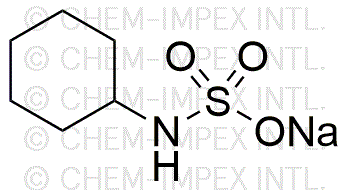Sodium N-cyclohexylsulfamate is widely utilized in research focused on:
- Agriculture: This compound serves as an effective herbicide, helping to control unwanted plant growth while minimizing damage to crops. Its selective action is beneficial for farmers looking to maintain healthy yields.
- Pharmaceuticals: It is used in the synthesis of various pharmaceutical compounds, providing a versatile building block for drug development. This application is crucial for researchers aiming to create new medications.
- Chemical Synthesis: Sodium N-cyclohexylsulfamate acts as a reagent in organic chemistry, facilitating reactions that produce complex molecules. This property is valuable for chemists working on innovative materials and compounds.
- Environmental Science: The compound is studied for its potential in wastewater treatment processes, helping to remove contaminants effectively. This application addresses environmental challenges and supports sustainability efforts.
- Food Industry: It is explored as a food additive for its potential to enhance flavor and preservation. This application is particularly relevant for food scientists looking to improve product quality and shelf life.
General Information
Properties
Safety and Regulations
Applications
Sodium N-cyclohexylsulfamate is widely utilized in research focused on:
- Agriculture: This compound serves as an effective herbicide, helping to control unwanted plant growth while minimizing damage to crops. Its selective action is beneficial for farmers looking to maintain healthy yields.
- Pharmaceuticals: It is used in the synthesis of various pharmaceutical compounds, providing a versatile building block for drug development. This application is crucial for researchers aiming to create new medications.
- Chemical Synthesis: Sodium N-cyclohexylsulfamate acts as a reagent in organic chemistry, facilitating reactions that produce complex molecules. This property is valuable for chemists working on innovative materials and compounds.
- Environmental Science: The compound is studied for its potential in wastewater treatment processes, helping to remove contaminants effectively. This application addresses environmental challenges and supports sustainability efforts.
- Food Industry: It is explored as a food additive for its potential to enhance flavor and preservation. This application is particularly relevant for food scientists looking to improve product quality and shelf life.
Documents
Safety Data Sheets (SDS)
The SDS provides comprehensive safety information on handling, storage, and disposal of the product.
Product Specification (PS)
The PS provides a comprehensive breakdown of the product’s properties, including chemical composition, physical state, purity, and storage requirements. It also details acceptable quality ranges and the product's intended applications.
Certificates of Analysis (COA)
Search for Certificates of Analysis (COA) by entering the products Lot Number. Lot and Batch Numbers can be found on a product’s label following the words ‘Lot’ or ‘Batch’.
*Catalog Number
*Lot Number
Certificates Of Origin (COO)
This COO confirms the country where the product was manufactured, and also details the materials and components used in it and whether it is derived from natural, synthetic, or other specific sources. This certificate may be required for customs, trade, and regulatory compliance.
*Catalog Number
*Lot Number
Safety Data Sheets (SDS)
The SDS provides comprehensive safety information on handling, storage, and disposal of the product.
DownloadProduct Specification (PS)
The PS provides a comprehensive breakdown of the product’s properties, including chemical composition, physical state, purity, and storage requirements. It also details acceptable quality ranges and the product's intended applications.
DownloadCertificates of Analysis (COA)
Search for Certificates of Analysis (COA) by entering the products Lot Number. Lot and Batch Numbers can be found on a product’s label following the words ‘Lot’ or ‘Batch’.
*Catalog Number
*Lot Number
Certificates Of Origin (COO)
This COO confirms the country where the product was manufactured, and also details the materials and components used in it and whether it is derived from natural, synthetic, or other specific sources. This certificate may be required for customs, trade, and regulatory compliance.


